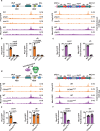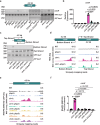PhpCNF-Y transcription factor infiltrates heterochromatin to generate cryptic intron-containing transcripts crucial for small RNA production
- PMID: 39747188
- PMCID: PMC11696164
- DOI: 10.1038/s41467-024-55736-3
PhpCNF-Y transcription factor infiltrates heterochromatin to generate cryptic intron-containing transcripts crucial for small RNA production
Abstract
The assembly of repressive heterochromatin in eukaryotic genomes is crucial for silencing lineage-inappropriate genes and repetitive DNA elements. Paradoxically, transcription of repetitive elements within constitutive heterochromatin domains is required for RNA-based mechanisms, such as the RNAi pathway, to target heterochromatin assembly proteins. However, the mechanism by which heterochromatic repeats are transcribed has been unclear. Using fission yeast, we show that the conserved trimeric transcription factor (TF) PhpCNF-Y complex can infiltrate constitutive heterochromatin via its histone-fold domains to transcribe repeat elements. PhpCNF-Y collaborates with a Zn-finger containing TF to bind repeat promoter regions with CCAAT boxes. Mutating either the TFs or the CCAAT binding site disrupts the transcription of heterochromatic repeats. Although repeat elements are transcribed from both strands, PhpCNF-Y-dependent transcripts originate from only one strand. These TF-driven transcripts contain multiple cryptic introns which are required for the generation of small interfering RNAs (siRNAs) via a mechanism involving the spliceosome and RNAi machinery. Our analyses show that siRNA production by this TF-mediated transcription pathway is critical for heterochromatin nucleation at target repeat loci. This study reveals a mechanism by which heterochromatic repeats are transcribed, initiating their own silencing by triggering a primary cascade that produces siRNAs necessary for heterochromatin nucleation.
© 2024. This is a U.S. Government work and not under copyright protection in the US; foreign copyright protection may apply.
Conflict of interest statement
Competing interests: The authors declare no competing interests.
Figures








References
Publication types
MeSH terms
Substances
Associated data
- Actions
Grants and funding
- ZIA BC010523/ImNIH/Intramural NIH HHS/United States
- ZIA BC011208/ImNIH/Intramural NIH HHS/United States
- ZIA BC 011208/U.S. Department of Health & Human Services | NIH | National Cancer Institute (NCI)
- ZIA BC 010523/U.S. Department of Health & Human Services | NIH | National Cancer Institute (NCI)
LinkOut - more resources
Full Text Sources
Molecular Biology Databases
Miscellaneous

